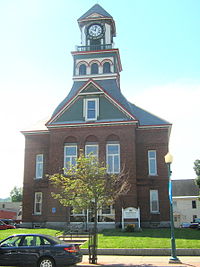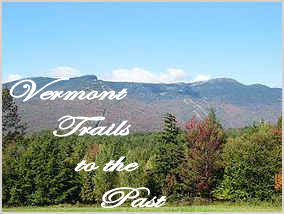Trails to the Past of Vermont is requesting any genealogy materials that you may have such as Obituaries, News Clippings, Wills, Deaths, Births, and Marriages, You do not need the certificates, but only the source of the information. If you should happen to have any of these items, please email them to Marie Miller, the Northeast District Administrator. Thank you.
 To the left is a photo of the court house in Newport which is the county seat of Orleans County In 1753, the Abenakis brought the ransomed John Stark down Lake Memphremagog and came ashore where Newport is now. They then traveled southeast to his home in New Hampshire.
To the left is a photo of the court house in Newport which is the county seat of Orleans County In 1753, the Abenakis brought the ransomed John Stark down Lake Memphremagog and came ashore where Newport is now. They then traveled southeast to his home in New Hampshire.
Rogers' Rangers were forced to retreat through the county following their attack on Saint-Francis, Quebec in 1759. To confound their avenging pursuers, they split up on the east shore of Lake Memphremagog. One group followed the Clyde River. Another followed the Barton River south to the falls at the outlet of Crystal Lake where they were able to catch fish. From there, they continued south over the summit into the Passumpsic River Valley.
The British Crown sent out surveyors to mark the border between its two colonies of Canada and America in accordance with the Quebec Act of 1774. This was supposed to be on the 45th parallel north. The result, however was a crooked line up to .75 miles (1.21 km) north of this intended border. This was resolved in favor of the crooked line by the Webster–Ashburton Treaty of 1842. This affected Orleans County, particularly Derby Line, which would have otherwise reverted to Canada.
In 1779 or 1780, General Moses Hazen constructed the Bayley-Hazen Military Road from Newbury, Vermont through Hardwick, Greensboro, Craftsbury, and Albany to Hazen's Notch in northern Vermont. This purpose of this road was to invade Canada. It was never used for that purpose, but was instrumental in the settlement of this area. However, it was five or more years before the wilderness was inhabited by other than a few Abenaki Indians, and that during the summer.
Vermont was divided into two counties in March, 1778. In 1781 the legislature divided the northernmost county, Cumberland, into three counties: Windham and Windsor, located about where they are now. The northern remainder was called Orange county. This latter tract nearly corresponded with the old New York county of Gloucester, organized by that province March 16, 1770, with Newbury as the shire town.
The state granted a town to Ebenezer Crafts, and sixty-three associates, on November 6, 1780. The town name was changed to Craftsbury, in honor of Ebenezer Crafts on October 27, 1790. Crafts was the first settler in the county.
On September 3, 1783, as a result of the signing of the Treaty of Paris the Revolutionary War ended with Great Britain recognizing the independence of the United States. Vermont's border with Quebec was established at 45 degrees north latitude.
From 1791 to 1793, Timothy Hinman built what is now called the "Hinman Settler Road" linking Greensboro north to Derby and Canada.
On November 5, 1792, the legislature divided Chittenden and Orange counties into six separate counties, as follows: Chittenden, Orange, Franklin, Caledonia, Essex, and Orleans. No reason is given for the county being named after Orléans, France.
Orleans lost territory when the new Jefferson county was created in 1797.
In 1810, Runaway Pond suddenly flooded the Barton River Valley with 1,988,000,000 US gallons of water in the greatest natural catastrophe in Orleans County post-Columbian history. Incredibly, no lives were lost.
On December 27, 1813, the county was invaded by British militia from nearby Stanstead, Quebec, during the War of 1812 in order to destroy an undefended barracks at Derby and to forage for supplies. No one was injured. Until the invasion, local inhabitants, like most New Englanders, opposed the war. A number had smuggled supplies to the British. After the invasion, their enthusiasm for their neighbors diminished substantially.
June 1816 brought 1 foot of snow to the county followed by agricultural devastation. 1816 became known as the Year without a summer.
When Lamoille county was formed in October 1835, Orleans lost the towns of Eden, Hyde Park, Morristown, and Wolcott.
In 1858, Barton (and Orleans County) obtained a triangular piece of land from Sheffield (and Caledonia County) which included all of May Pond, the entire area south of Crystal Lake, and the village of South Barton.
During the Civil War, Company D, 4th Vermont Infantry was recruited largely from Orleans County. Volunteers from the county joined the Union Army in response to a call from the government. In September 1861, they joined the Vermont 6th Vermont Infantry, and helped fill out Company D. The regiment ultimately became part of the First Vermont Brigade. In 1864, 267 men from the 11th Vermont Infantry were captured at the Weldon Railroad in the Overland campaign. today better known as the Battle of Jerusalem Plank Road. It was a considerable source of local concern when it was learned that these prisoners had been taken to Andersonville prison, a place known, even then, for its poor living conditions. 54 of these prisoners were from Orleans County. Many of them died in prison.
French immigration into the county started before the Civil War. It continued afterwards. Like the rest of the state, Orleans County sent up to one-quarter of its eligible men to the Civil War. Ten percent of these died. Others came back too maimed to continue working their farms, which most volunteers had left. The sudden offering of many farms for sale in the mid-1860s resulted in a precipitous drop in farm prices. Nearby French-Canadians took advantage of this. As a result of this and loss of native farm labor to other states, Vermont, particularly the northern part, saw many immigrants then and through the turn of the twentieth century.
After increasing in population since its founding, the county began losing population starting in 1900. It reached a twentieth century low in population in 1960 at 20,143. The population has risen ever since.
In 1903, the county purchased a jail, mail order. It housed about 350 people annually. It once held 140 people at one time, a fallout from a widely attended 1973 rock concert. The jail closed in 1995. It is listed on the National Register of Historic Places.
In 1903, a state law allowed each town to decide whether to permit the sale of liquor within their boundaries. By 1905, no town in the county allowed the sale of alcoholic beverages. The change was not that dramatic since state law had theoretically forbidden alcohol prior to 1903, but this law was unevenly enforced.
Cities and Towns



